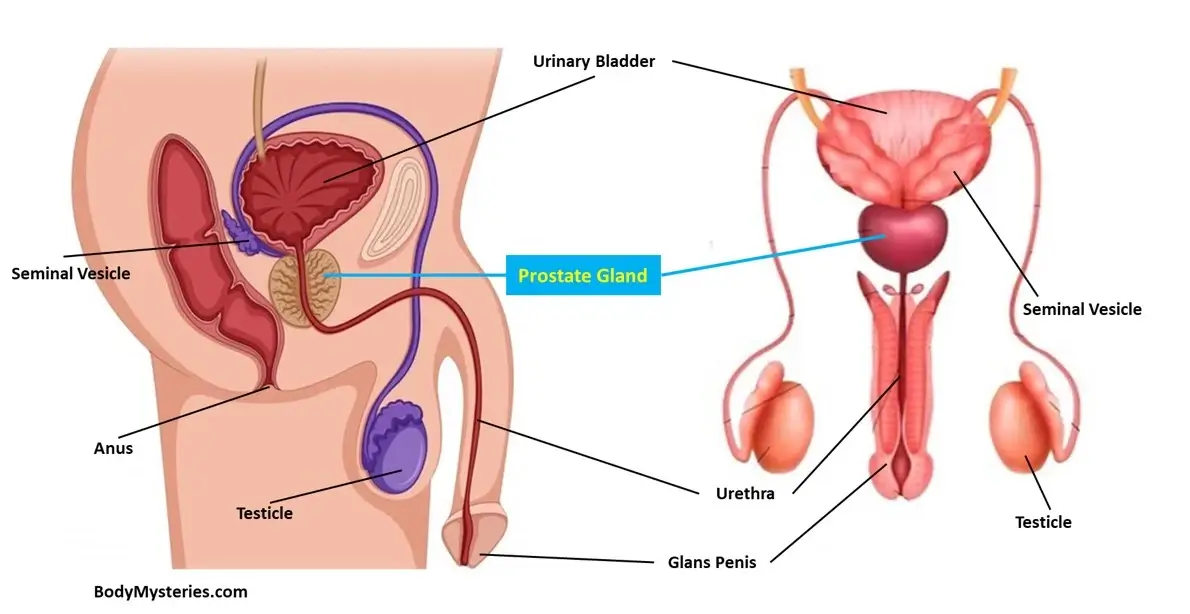
Introduction
The prostate gland, often overlooked in discussions of the male reproductive system, plays an essential role in men’s health and well-being. It is nestled discreetly below the bladder and in front of the rectum. This small, walnut-sized organ is a powerhouse of functions that impact both the reproductive and urinary aspects of a man’s life.
In this comprehensive exploration, we will dive into the world of the prostate gland. We will understand its anatomy, its vital contributions to male physiology, and how it elegantly orchestrates multiple functions. Furthermore, from its unique positioning surrounding the urethra to its role in sperm activation and controlling the flow of urine and semen, the prostate gland deserves recognition for the integral part it plays in a man’s life.
In this article;
- What is a prostate gland?
- Importance of Prostate Gland in the male reproductive system
- Anatomy of the Prostate Gland
- How the prostate gland surrounds the urethra?
- What are the Important Functions of Prostate Gland?
What is a prostate gland?
The prostate gland, which is a part of the male reproductive system, is a small organ positioned just below the bladder and in front of the rectum. Its primary function is to produce a milky fluid that nourishes and transports sperm during ejaculation, combining with sperm from the testicles to form semen. Surrounding the prostate gland is a network of muscles and nerves that control the release of urine and semen.
As men age, the prostate gland can undergo changes, including enlargement (known as benign prostatic hyperplasia or BPH) or the development of prostate cancer. Maintaining prostate health is crucial for men’s overall well-being. Therefore, regular check-ups with a healthcare provider are essential for monitoring and addressing potential prostate-related issues.
Importance of Prostate Gland in the male reproductive system
The prostate gland serves several vital roles in male sexual health and fertility. It is a crucial component of the male reproductive system. Firstly, it produces a significant portion of seminal fluid, which nourishes and protects sperm, aiding in their motility and viability. Additionally, the prostate helps control the release of semen during ejaculation.
It also contributes to urine flow regulation and produces prostate-specific antigen (PSA) to aid in liquefying semen. Hormonally regulated, it can also be affected by changes in testosterone levels. Overall, the prostate’s functions support male fertility, sexual function, and urinary health, making its maintenance essential for overall well-being.
Anatomy of the Prostate Gland
Within the male reproductive system resides the small yet significant walnut-sized prostate gland. Its primary function involves producing seminal fluid, which in turn nourishes and transports sperm during ejaculation. Understanding prostate anatomy is crucial for diagnosing and treating prostate conditions. Moreover, as men age, the imperative of maintaining prostate health becomes more pronounced, necessitating the regular undertaking of prostate exams and screenings.
Here’s an overview of the anatomy of the prostate gland:
Location:
The prostate gland is situated just below the bladder, surrounding the urethra, which is the tube that carries urine and semen out of the body. It is located in front of the rectum.
Shape and Size:
The prostate gland typically measures about 3-4 centimeters in length and weighs around 20-25 grams in adult men. It has a roughly conical or heart-shaped structure, and its size can vary among individuals.
Lobes:
Anatomically, experts often divide the prostate gland into lobes. This division is crucial for diagnosing and treating various prostate-related conditions, including enlargement (BPH) or cancer, as specific lobes may demand different treatment approaches. Typically, the prostate gland comprises four lobes.
These lobes are:
Anterior Lobe: This is the front portion of the prostate and doesn’t contain glandular tissue. It’s mainly composed of muscle fibers.
Posterior Lobe: This is the larger, glandular part of the prostate responsible for producing seminal fluid. It is positioned at the back of the prostate gland, it faces the rectum.
Lateral Lobes: There are two lateral lobes, one on each side of the prostate gland. They are located on the left and right sides, adjacent to the urethra.
Median Lobe: This lobe is in the middle of the prostate gland, surrounding the urethra.

Zones:
Experts divide the prostate gland into anatomical zones or regions based on its histological structure. This division holds significant importance in diagnosing and treating prostate-related conditions. Problems in specific zones can have diverse clinical implications, necessitating distinct management approaches.
The prostate gland zones are:
Peripheral Zone: This outermost zone constitutes the majority of the prostate tissue. This is the area where the majority of prostate cancers originate. It surrounds the urethra and can be felt during a digital rectal examination (DRE).
Central Zone: This zone is located at the back of the prostate and surrounds the ejaculatory ducts. It plays a role in the transport of seminal fluid during ejaculation.
Transitional Zone: This innermost zone surrounds the urethra as it exits the bladder. It is situated near the center of the prostate. It’s the region where benign prostatic hyperplasia (BPH) often occurs, leading to enlargement of the prostate and potential urinary symptoms.
Anterior Fibromuscular Stroma: This region consists of connective tissue and smooth muscle and is found at the front of the prostate. It does not contain glandular tissue.
Ducts and Glands:
Numerous small ducts and glands within the prostate gland produce the components of seminal fluid, which include enzymes, proteins, and fluids. These secretions actively nourish and protect sperm during ejaculation.
Blood Supply and Nerves:
Various arteries supply blood to the prostate gland, and a network of nerves innervates it. These blood vessels and nerves play crucial roles in regulating the gland’s function.
How the prostate gland surrounds the urethra?
The prostate gland, a vital component of the male reproductive and urinary systems, resides just below the bladder and in front of the rectum. Its unique anatomical feature involves surrounding the urethra, serving as a support structure that maintains urethral integrity and prevents collapse during various bodily functions. This positioning significantly impacts both urinary and reproductive functions. Regarding urination, a healthy prostate ensures unobstructed urine flow, but an enlarged prostate, as observed in benign prostatic hyperplasia (BPH), can result in urinary symptoms.
In the realm of reproduction, the prostate’s role extends to the production of seminal fluid, which nourishes and transports sperm. Additionally, its muscular component, the prostatic sphincter, aids in controlling the release of urine and semen during both urination and ejaculation. This anatomical arrangement underscores the prostate gland’s pivotal role in male physiology, emphasizing the importance of monitoring prostate health as men age.
What are the Important Functions of Prostate Gland?
The prostate gland serves the following important functions in the male reproductive system:
Production of Prostatic Fluid:
The prostate gland plays a vital role in the male reproductive system by actively producing prostatic fluid. This essential function involves the secretion of a fluid rich in enzymes, proteins, and other substances necessary for nourishing and safeguarding sperm during their journey through the male reproductive tract. When a man ejaculates, the prostate gland releases this prostatic fluid. This fluid combines with sperm from the testicles, fluid from the seminal vesicles, and other components to form semen.
This active production of prostatic fluid ensures that sperm receive the nutrients and support required for their motility, viability, and ability to fertilize an egg. In summary, the prostate gland actively participates in the male reproductive process by producing prostatic fluid, which significantly contributes to successful reproduction.
Sperm Activation:
The prostate gland actively contributes to sperm activation by producing prostatic fluid, a crucial component of semen. The prostatic fluid contains enzymes and other substances that actively aid in activating and increasing the motility of sperm. During ejaculation, the prostate gland releases this fluid, which then combines with sperm from the testicles, seminal fluid from the seminal vesicles, and other components to form semen.
The enzymes present in prostatic fluid actively facilitate the liquefaction of the ejaculate, allowing sperm to swim freely and effectively. This active process is essential for the successful fertilization of an egg during sexual reproduction. In summary, the prostate gland plays an active role in the activation and support of sperm by producing prostatic fluid, thereby aiding in their motility and overall functionality.
Control of Urine and Semen Flow:
The prostatic sphincter, a muscular component of the prostate gland, plays a crucial role in controlling the flow of urine and semen. It helps regulate the release of these fluids during urination and ejaculation, ensuring that urine and semen are not expelled simultaneously. During urination, the prostatic sphincter contracts to close off the urethra’s passage from the bladder, preventing the release of urine into the urethra.
Conversely, during ejaculation, the prostatic sphincter relaxes, allowing for the release of seminal fluid into the urethra and facilitating the expulsion of semen from the body. This active control ensures that these fluids are released at the appropriate times and into the correct pathways within the male reproductive and urinary systems.
Muscle Contraction:
The smooth muscle tissue within the prostate gland surrounds the urethra, which passes through the gland’s center. These smooth muscles actively maintain the integrity of the urethra, preventing it from collapsing or closing off during various bodily functions like urination and ejaculation. Additionally, they play a pivotal role in regulating the flow of urine and semen, ensuring the proper direction and expulsion of these fluids from the body as required. This muscle contraction function is a vital component of the overall operation of the male reproductive and urinary systems.
Reproductive Health:
The prostate gland plays a pivotal role in male reproductive health. Specifically, it actively contributes to male fertility and reproductive function through various mechanisms. One of its key functions is the production of seminal fluid, which is a vital component of semen. This fluid serves multiple essential roles, including nourishing and protecting sperm, enhancing their motility, and aiding in the liquefaction of semen after ejaculation. These functions collectively support the process of fertilization and contribute to the maintenance of reproductive health in men.
Prostate-Specific Antigen (PSA) Production
The prostate gland primarily secretes prostate-specific antigen (PSA) into the seminal fluid. PSA plays a crucial role in the process of liquefying semen after ejaculation, facilitating the sperm’s ability to move effectively. This enzyme functions by breaking down the proteins in semen, reducing its viscosity, and enabling sperm to swim freely. Although PSA production occurs within the prostate gland, it can also be detected in the bloodstream. Elevated levels of PSA in the blood may indicate various prostate-related conditions, including prostate cancer, prostatitis, or benign prostatic hyperplasia (BPH).
In this context, monitoring PSA levels through blood tests is a common method for assessing prostate health and detecting potential issues. However, it’s important to note that an elevated PSA level does not necessarily confirm the presence of cancer. Further diagnostic tests may be required for a conclusive diagnosis.
Conclusion
The prostate gland, a modest yet formidable organ, is a cornerstone of male reproductive and urinary health. Its multiple functions, from the production of seminal fluid to the control of urine and semen flow, underscore its significance. Moreover, the intricate gland’s positioning around the urethra ensures seamless coordination between the reproductive and urinary systems.
As men age, understanding the prostate gland becomes increasingly vital because it may undergo changes that demand attention. To address this, regular check-ups and screenings are crucial for maintaining prostate health, allowing for early detection and management of potential issues. Despite its modest size, the prostate gland stands tall as a guardian of male well-being, deserving our appreciation and understanding.



Very well written